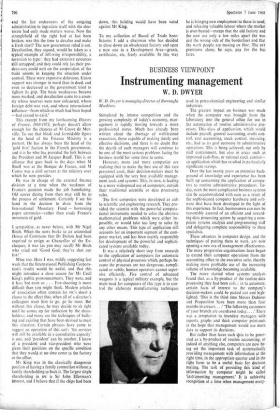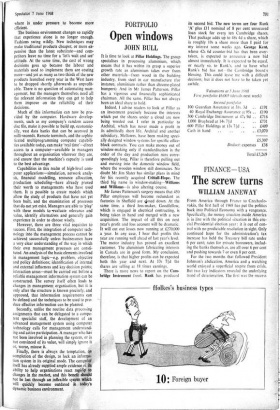Instrumenting management
BUSINESS VIEWPOINT
W. D. DWYER
W. D. Dwyer is managing director of Burroughs Machines.
Stimulated by intense competition and the growing complexity of today's economy, man- agement is rapidly moving towards a more professional status. Much has already been written about the shortage of well-trained executives, those capable of making timely and effective decisions, and there is no doubt that the dearth of such managers will continue to be one of the most serious problems facing the business •world for some time to come.
However, more and more companies are realising that to make the best use of this rare personnel asset, their decision-makers must be equipped with the very best available manage- ment tools and systems. This, in turn, is leading to a more widespread use of computers, outside their traditional scientific or data processing roles.
The first computers were developed as aids to scientific and engineering research. They pro- vided the scientist with the powerful computa- tional instruments needed to solve the abstruse mathematical problems which were either im- possible, or would take too long to solve by any other means. This type of application still accounts for an important segment of the com- puter market, and has been mainly responsible for development of the powerful and sophisti- cated systems available today.
It was a relatively short step from research to the application of computers for automatic control of physical processes which, perhaps be- cause the processes are too dangerous, compli- cated or subtle, human operators cannot super- vise efficiently. Fire control of advanced weapons is a typical military example, but the main need for computers of this type is to con- trol the elaborate manufacturing techniques used in petro-chemical engineering and similar industries.
The greatest impact on business was made when the computer was brought from the laboratory into the general office for use in the automation of routine administrative pro- cesses. This class of application, which would include payroll, general accounting, credit con- trol, cost accounting, stock control, invoicing, etc., had as its goal economy in administrative operations. This is being achieved, net only by staff containment, but also in areas such as improved cash-flow, or rational stock control— an application which has resulted in particularly significant savings.
Over the last twenty years an extensive back- ground of knowledge and experience has been built up concerning the 'application of compu- ters to routine administrative procedures. To- day, even the most complicated business systems can be accommodated with ease as a result of the sophisticated computer hardware and soft- ware that have been developed in the light of this experience. In fact, businessmen can now be reasonably assured of an efficient and reward- ing data processing system by acquiring a com- petent systems analysis and programming staff and delegating complete responsibility to these specialists.
These advances in computer design, and the techniques of putting them to work, are now opening a new era of management effectiveness. The more progressive organisations have begun to extend their computer operations from the accounting office to the executive suite, thereby making more profitable use of the increasing volume of knowledge becoming available.
The move started when systems analysts found that, as a by-product of the routine data processing they had been calk.: in to automate, certain facts of interest to the company's decision-makers could be picked out and high- lighted. `This is the third time Messrs Dubious and Proposition have been more than four months in arrears. ..."The following customers of your branch are overdrawn today. . . .' There was a temptation to inundate managers with reports, graphs and thick computer print-outs in the hope that management would use more data to support its decisions. .
But rather than leave such data to be gener- ated as a by-product of routine accounting, or indeed of anything else, computers are now be- ing set the important task of systematically providing management with information at the right time, in the appropriate quarter and in the right form to be a useful basis for decision Making. The task Of providing this kind of information by computer might be called lastrtanenting manageinent.' It is achieving recognition at a time•when management every- where is under pressure to become more efficient.
The business environment changes so rapidly that experience alone is no longer enough.
Fashions swing wildly. New techniques may make traditional products cheaper, or more ex- pensive than the latest substitute—and com- petitors leave no time for a 'let's wait and see' attitude. At the same time, the cost of wrong decisions goes up because the labour and materials used to implement them are costing- more—and yet as many as two thirds of the new products launched every year in the West have to be dropped shortly afterwards as unprofit- able. There is no question of automating man- agement, but the managers themselves need all the relevant information they can get to help them improve on the reliability of their decisions.
Much of this information can now be pro- vided by the computer. Hardware develop-
ments, such as my company's random access
disc file, make it possible to build up, economic- ally, vast data banks that can be accessed in milli-seconds. Remote terminals, and the sophis- ticated multiprogramming computer capabili- ties available today, can make 'real time'—direct access to a computer—available to managers throughout an organisation wherever they are, and ensure that the machine's capacity is used to the best advantage.
Capabilities in this realm of high-level com- puter applications—simulation, network analy- sis, financial modelling, resource allocation, production scheduling—have already proved their worth to managements who have used them. It is possible to create models which allow the study of products that have not yet been built, and the examination of processes
that do .not yet exist. Managers are able to 'play' with these models to -evaluate relevance and value, identify alternatives and generally gain experience in order to choose wisely.
However, there are three vital requisites to success. First, the integration of computer tech- nology into the management process cannot be achieved successfully unless businessmen have a very clear understanding of the way in which their own management processes are consti- tuted. An analysis of the basic.elements involved in management logic—e.g. problem, objective and policy definitions; identification of internal
and external influences and key decision points; interaction areas—must he carried out before a
reliable management information system can be constructed. The survey itself often leads to changes in management organisation, but it is
only after the structure is known precisely, and approved, that information requirements can be defined and the techniques to be used to pro- duce effective information can be planned.
Secondly, unlike the routine data processing assignments that can be delegated to a compe- tent -specialist staff, the development of an advanced management system using computer technology calls for management understand-
ing and active participation. A manager who has not been involved in planning the system, or is not convinced of its value, will simply ignore it or, worse, misuse it.
Finally, there is always the temptation, 4111 completion of the design, to lock an informa- tion system in its original mode. The competer itself has already supplied ample evidence of its ability to help orpnisations react rapialy to changes in,the market, and this benefit should not be left through an inflexible syyto which will qiicklY- become outdated t today's dynamic business environment. -







































 Previous page
Previous page